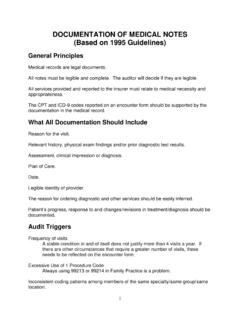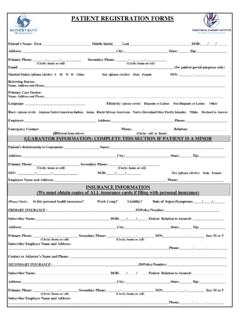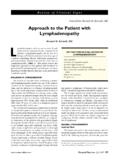Transcription of HIGHLIGHTS OF PRESCRIBING INFORMATION …
1 HIGHLIGHTS OF PRESCRIBING INFORMATION These HIGHLIGHTS do not include all the INFORMATION needed to use Dacogen safely and effectively. See full PRESCRIBING INFORMATION for Dacogen. DACOGEN (decitabine) for INJECTION Initial Approval: 2006 ------------------------RECENT MAJOR CHANGES----------------------------- Dosage and Administration ( ) 03/2010 -------------------------INDICATIONS AND USAGE------------------------------ Dacogen is a nucleoside metabolic inhibitor indicated for treatment of patients with myelodysplastic syndromes (MDS) including previously treated and untreated, de novo and secondary MDS of all French-American-British subtypes (refractory anemia, refractory anemia with ringed sideroblasts, refractory anemia with excess blasts, refractory anemia with excess blasts in transformation, and chronic myelomonocytic leukemia)
2 And intermediate-1, intermediate 2, and high-risk International Prognostic Scoring System groups. (1) ----------------------DOSAGE AND ADMINISTRATION----------------------- There are two regimens for Dacogen administration. With either regimen it is recommended that patients be treated for a minimum of 4 cycles; however, a complete or partial response may take longer than 4 cycles. (2) Treatment Regimen Option 1 Administer Dacogen at a dose of 15 mg/m2 by continuous intravenous infusion over 3 hours repeated every 8 hours for 3 days. Repeat cycle every 6 weeks. ( ) Treatment Regimen Option 2 Administer Dacogen at a dose of 20 mg/m2 by continuous intravenous infusion over 1 hour repeated daily for 5 days.
3 Repeat cycle every 4 weeks. ( ) -------------------DOSAGE FORMS AND STRENGTHS----------------------- Lyophilized powder in a single-dose vial, 50 mg/vial. (3) ---------------------------CONTRAINDICAT IONS--------------------------------- None --------------------WARNINGS AND PRECAUTIONS------------------------- Neutropenia and thrombocytopenia: Perform complete blood counts and platelet counts. ( ) Pregnancy: Can cause fetal harm. Advise women of potential risk to the fetus ( , ) Women of childbearing potential and men with female partners of childbearing potential should use effective contraception and avoid pregnancy ( , ) ---------------------------ADVERSE REACTIONS------------------------------- -- Most common adverse reactions (> 50%) are neutropenia, thrombocytopenia, anemia, and pyrexia.
4 ( ) To report SUSPECTED ADVERSE REACTIONS, contact Eisai, Inc. at 1-888-274-2378 or FDA at 1-800-FDA-1088 or See 17 for PATIENT COUNSELING INFORMATION . Revised: 03/2010 FULL PRESCRIBING INFORMATION : CONTENTS* 1 INDICATIONS AND USAGE 2 DOSAGE AND ADMINISTRATION Treatment Regimen Option 1 Treatment Regimen Option 2 Patients with Non-hematologic Toxicity Instructions for Intravenous Administration Preparation and Handling Precautions 3 DOSAGE FORMS AND STRENGTHS 4 CONTRAINDICATIONS 5 WARNINGS AND PRECAUTIONS Neutropenia and Thrombocytopenia Use in Pregnancy Use in Women of Childbearing Potential Use in Men 6 ADVERSE REACTIONS Clinical Studies Experience Post-Marketing Experience 7 DRUG INTERACTIONS 8 USE IN
5 SPECIFIC POPULATIONS Pregnancy Nursing Mothers Pediatric Use Geriatric Use Renal Impairment Hepatic Impairment 10 OVERDOSAGE 11 DESCRIPTION 12 CLINICAL PHARMACOLOGY Mechanism of Action Pharmacodynamics Pharmacokinetics 13 NONCLINICAL TOXICOLOGY Carcinogenesis, Mutagenesis, & Impairment of Fertility 14 CLINICAL STUDIES Controlled Trial Single-arm Studies 15 REFERENCES 16 HOW SUPPLIED/STORAGE AND HANDLING 17 PATIENT COUNSELING INFORMATION Instructions for Patients * Sections or subsections omitted from the full PRESCRIBING INFORMATION are not listed FULL PRESCRIBING INFORMATION 1 INDICATIONS AND USAGE Dacogen is indicated for treatment of patients with myelodysplastic syndromes (MDS)
6 Including previously treated and untreated, de novo and secondary MDS of all French-American-British subtypes (refractory anemia, refractory anemia with ringed sideroblasts, refractory anemia with excess blasts, refractory anemia with excess blasts in transformation, and chronic myelomonocytic leukemia) and intermediate-1, intermediate-2, and high-risk International Prognostic Scoring System groups. 2 DOSAGE AND ADMINISTRATION There are two regimens for Dacogen administration. With either regimen it is recommended that patients be treated for a minimum of 4 cycles; however, a complete or partial response may take longer than 4 cycles.
7 Complete blood counts and platelet counts should be performed as needed to monitor response and toxicity, but at a minimum, prior to each cycle. Liver chemistries and serum creatinine should be obtained prior to initiation of treatment. Treatment Regimen Option 1 Dacogen is administered at a dose of 15 mg/m2 by continuous intravenous infusion over 3 hours repeated every 8 hours for 3 days. This cycle should be repeated every 6 weeks. Patients may be premedicated with standard anti-emetic therapy. If hematologic recovery (ANC 1,000/ L and platelets 50,000/ L) from a previous Dacogen treatment cycle requires more than 6 weeks, then the next cycle of Dacogen therapy should be delayed and dosing temporarily reduced by following this algorithm: Recovery requiring more than 6, but less than 8 weeks Dacogen dosing to be delayed for up to 2 weeks and the dose temporarily reduced to 11 mg/m2 every 8 hours (33 mg/m2/day, 99 mg/m2/cycle) upon restarting therapy.
8 Recovery requiring more than 8, but less than 10 weeks Patient should be assessed for disease progression (by bone marrow aspirates); in the absence of progression, the Dacogen dose should be delayed up to 2 more weeks and the dose reduced to 11 mg/m2 every 8 hours (33 mg/m2/day, 99 mg/m2/cycle) upon restarting therapy, then maintained or increased in subsequent cycles as clinically indicated. Treatment Regimen Option 2 Dacogen is administered at a dose of 20 mg/m2 by continuous intravenous infusion over 1 hour repeated daily for 5 days. This cycle should be repeated every 4 weeks. Patients may be premedicated with standard anti-emetic therapy.
9 If myelosuppression is present, subsequent treatment cycles of Dacogen should be delayed until there is hematologic recovery (ANC 1,000/ L platelets 50,000/ L ). Patients with Non-hematologic Toxicity Following the first cycle of Dacogen treatment, if any of the following non-hematologic toxicities are present, Dacogen treatment should not be restarted until the toxicity is resolved: 1) serum creatinine 2 mg/dL; 2) SGPT, total bilirubin 2 times ULN; 3) and active or uncontrolled infection. Instructions for Intravenous Administration Dacogen is a cytotoxic drug and caution should be exercised when handling and preparing Dacogen.
10 Procedures for proper handling and disposal of antineoplastic drugs should be applied. Several guidances on this subject have been . Dacogen should be aseptically reconstituted with 10 mL of Sterile Water for Injection (USP); upon reconstitution, each mL contains approximately mg of decitabine at pH Immediately after reconstitution, the solution should be further diluted with Sodium Chloride Injection, 5% Dextrose Injection, or Lactated Ringer s Injection to a final drug concentration of - mg/mL. Unless used within 15 minutes of reconstitution, the diluted solution must be prepared using cold (2 C - 8 C) infusion fluids and stored at 2 C - 8 C (36 F - 46 F) for up to a maximum of 7 hours until administration.
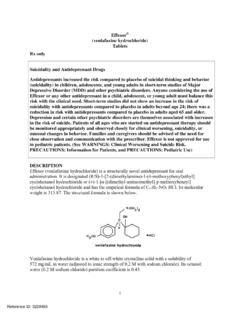
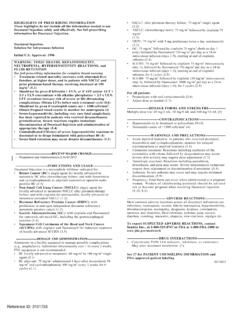
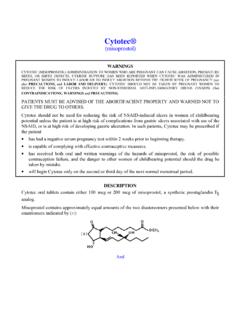
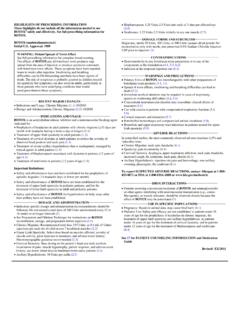
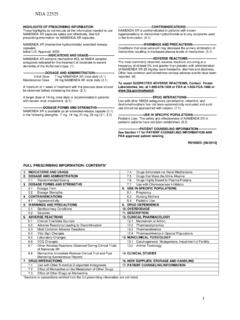
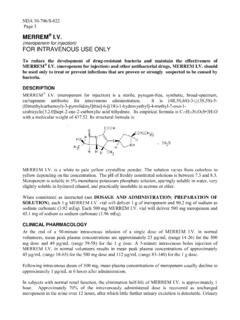
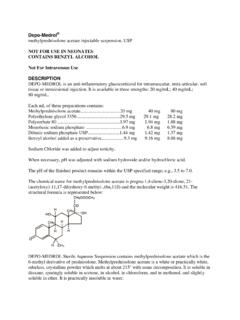
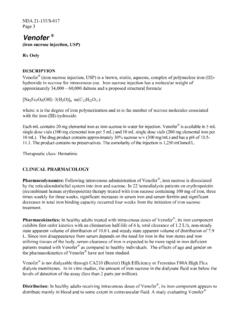
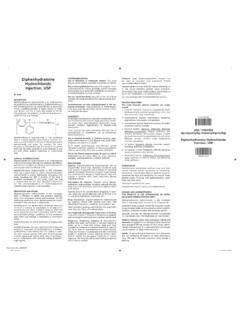
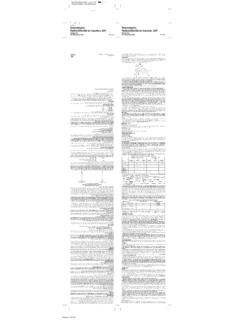

![[Product Monograph Template - Standard] - …](/cache/preview/a/9/a/b/c/6/8/3/thumb-a9abc683523644e52c439669ba6e5b27.jpg)
